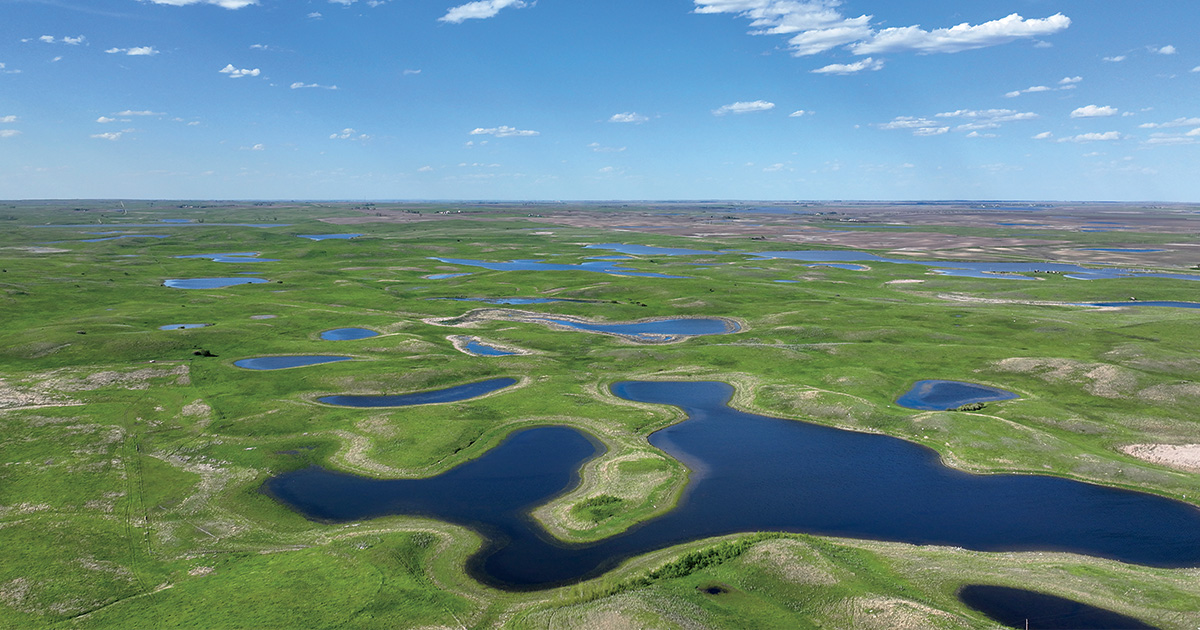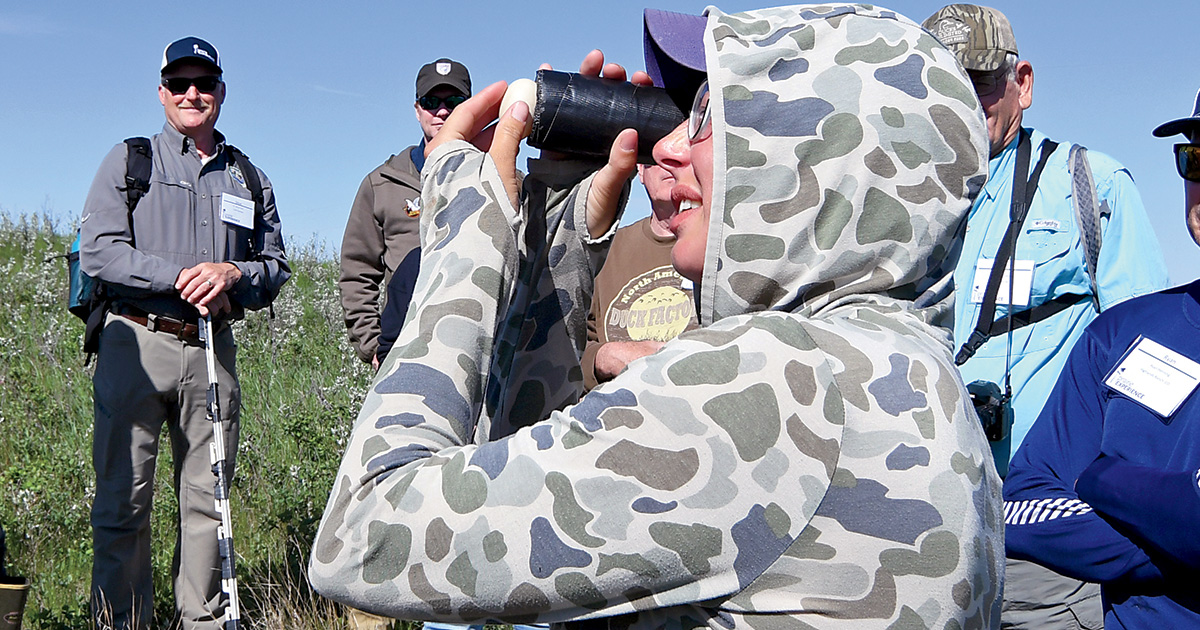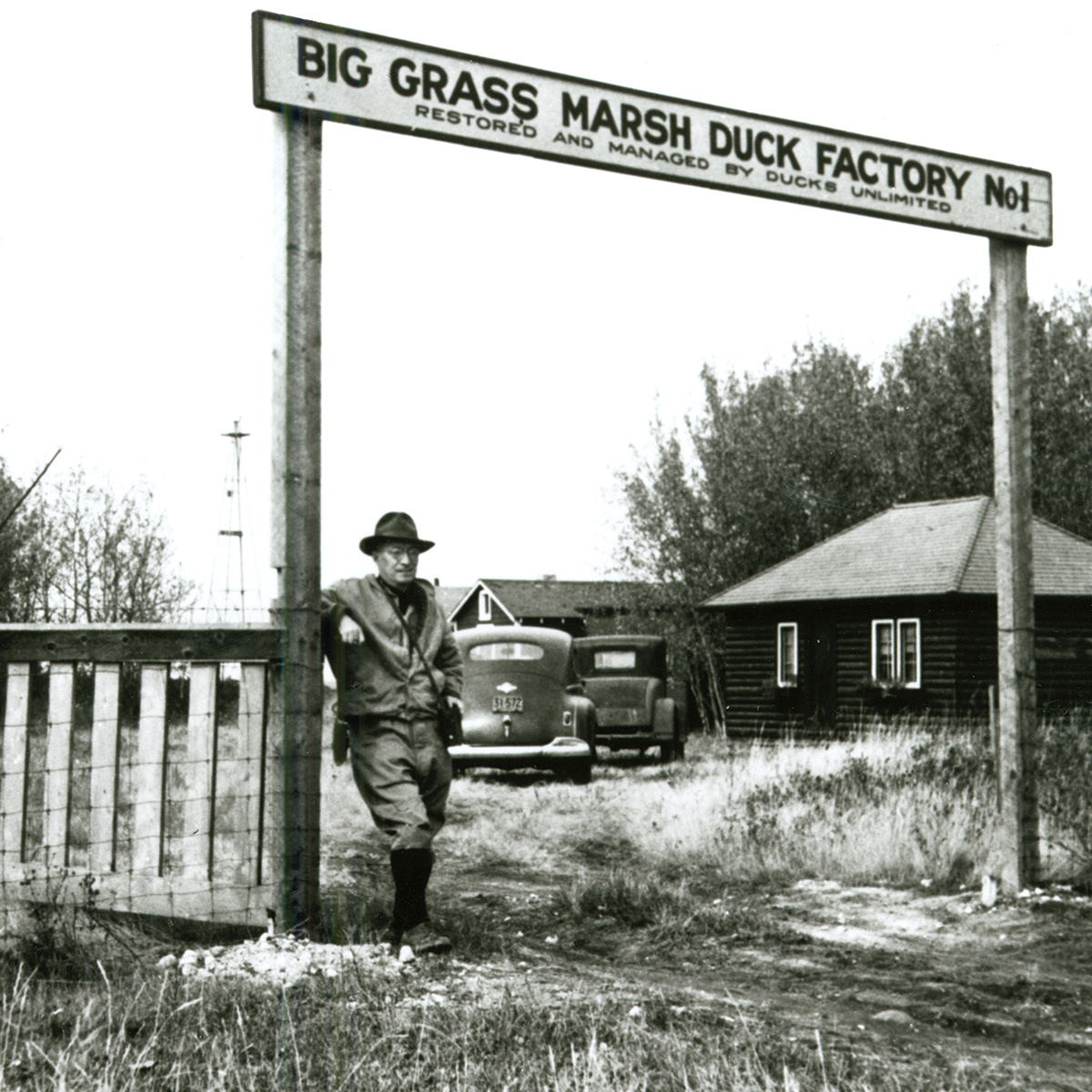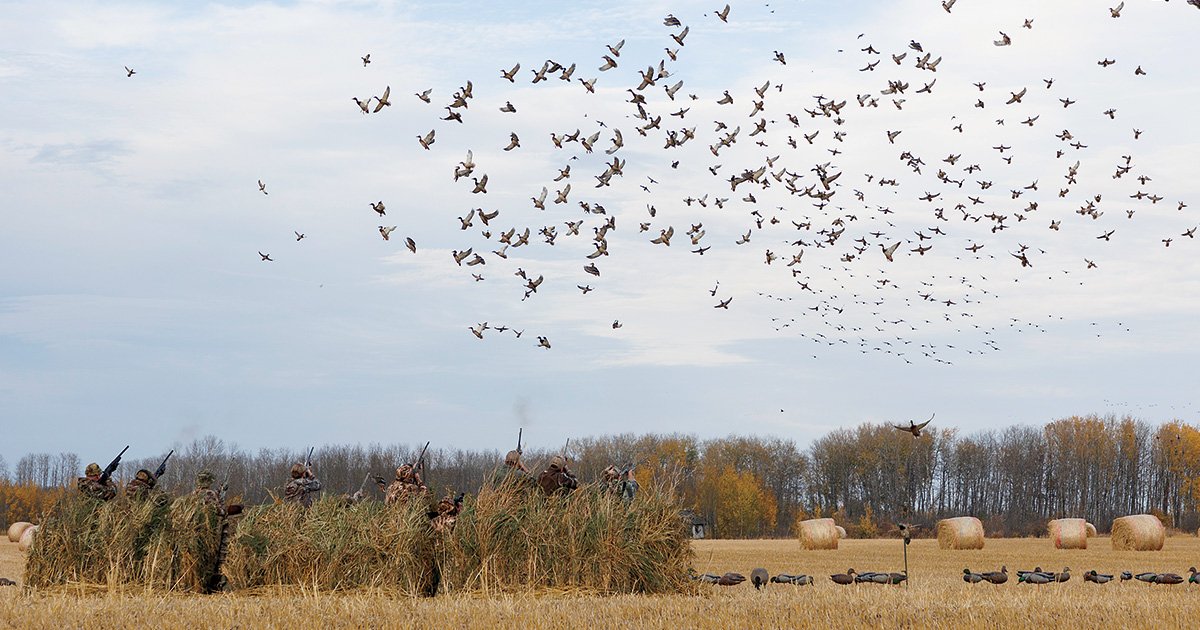Exploring the Duck Factory
A closer look at the Prairie Pothole Region, North America's most important waterfowl breeding area
A closer look at the Prairie Pothole Region, North America's most important waterfowl breeding area

It was a late summer day when Bruce Toay and several other Ducks Unlimited biologists put on their waders and headed to one of the many wetlands on the prairies of north-central South Dakota. Toay and his team were there in search of ducks, and as they reached the edge of the little pond they saw them. Lured by the promise of an easy meal, these ducks had been captured in a swim-in trap made of tightly woven wire.
Amid a flurry of quacks and flapping wings, the biologists gathered the birds by hand and recorded some basic information about each of them, including species, age, and whether it was a drake or a hen. Then they placed a small aluminum band on one leg of each duck before releasing all of them back into the wetland with the hope, Toay says, that the band would someday be recovered, most likely by a hunter.
“The information we gain from band returns is extremely important. It plays a role in how ducks are managed and helps shed light on waterfowl migration across the continent,” says Toay, who is DU’s manager of conservation programs in South Dakota. “And over the years, these band returns have also helped us gain a better understanding of just how important this area is in terms of continental duck production. Because of band returns, we know that if you shoot a mallard in Kansas, or a pintail in Arkansas, or even a blue-winged teal down along the Gulf Coast of Louisiana, there is a good chance that it was hatched thousands of miles away—here on the prairie.”
The wetlands and grasslands found in this area of South Dakota are part of a larger area called the Prairie Pothole Region, also known as the Duck Factory, thanks to the region’s role in producing the mallards, gadwalls, pintails, blue-winged teal, canvasbacks, redheads, and other species that show up in the skies over all four major waterfowl flyways. What follows is a look at the habitat found within this region that is so vital for duck production, what Ducks Unlimited is doing to protect it, and why the Duck Factory is a great destination for hunters.

A DU biologist examines a duck egg to determine when it will hatch. Nesting hens produce large numbers of ducklings in areas with numerous small wetlands surrounded by grassland.
The Prairie Pothole Region is the heart of what was once the largest grassland landscape in the world, containing millions of pothole wetlands that were created as Ice Age glaciers receded some 10,000 years ago.
At first glance, these prairie potholes may not look like much. They are small and shallow, and many contain water for only a few months out of the year, but they are the engine that drives duck production in this area. “It all comes down to habitat,” explains Dr. Johann Walker, director of operations in DU’s Great Plains Region. “These small, shallow, seasonal wetlands provide much of the food and cover that breeding ducks need to successfully nest and raise their ducklings.”
In spring, mallards, pintails, and other waterfowl species return to the prairies as the pothole wetlands are beginning to thaw, and it’s there that female ducks find the invertebrates and plant seeds they need to recover from their long migration, produce eggs, and take care of them during the incubation period.
“Later, as ducklings begin to hatch, seasonal wetlands continue to provide important food resources and habitat for hens and their broods,” Walker says. “On landscapes with an abundance of healthy seasonal wetlands, brood-rearing females and their ducklings may not have to move as often or as far overland in search of food and shelter, and this reduces their vulnerability to predators and the elements.”
Research has shown that an abundance of seasonal wetlands is also associated with larger clutches of eggs and higher hatch rates, and should a hen lose a nest in one of these areas, she is much more likely to attempt to renest. So, when female ducks experience a breeding and nesting season with a large number of seasonal wetlands on the prairie, hunters can expect to see more ducks heading south in the fall.
“That is precisely what occurred during periods of the 1970s, 1990s, and 2000s, when water was abundant in the Prairie Pothole Region,” Walker says. “The impressive fall flights witnessed during these banner years would never have materialized without millions of small wetland basins on the prairie landscape, and this is why the conservation of small, seasonal wetlands is crucial to sustaining duck populations.”

Ducks Unlimited was founded in 1937 to conserve wetlands in the Prairie Pothole Region.
Ducks Unlimited has been a leading voice for the conservation of the Duck Factory since 1937, when the organization was founded. Over the decades, DU has been committed to working with its conservation partners in Canada and the United States to restore and protect wetlands and grasslands across the entire Prairie Pothole Region and to support landscape-scale programs that benefit these habitat types.
“This is a landscape that is super dynamic, meaning that it may be wet in South Dakota and North Dakota for a couple of years, and then the precipitation patterns change and those states go dry, but then Alberta and Saskatchewan are wet, or Manitoba, and so on,” explains Dr. Scott Stephens, DU Canada’s director of regional operations for the prairies and Boreal. “At Ducks Unlimited we know that if we want to maintain duck populations at a high level, we need to keep the whole of the Prairie Pothole Region intact, so that when we get the right environmental conditions, the table is set and the ducks can do what they do.”
This work by Ducks Unlimited and its partners includes restoring wetlands that have been drained, returning native grasses to the landscape, partnering with landowners to protect those areas of remaining waterfowl habitat, and working with governmental leaders and agencies to support programs that benefit wetlands. This work also includes educating the public about conservation and highlighting the immense role that healthy wetlands play in promoting soil health, mitigating flood risks for communities, and other societal benefits.
“The Prairie Pothole Region is our highest priority,” Stephens says. “Keeping this habitat base intact is what Ducks Unlimited believes is the road for long-term, sustainable duck populations across the continent.”

In addition to being a vital area for duck production, the Prairie Pothole Region is home to some fantastic hunting. And while there probably isn’t a wrong time to be in the Duck Factory during the hunting season, different times will produce different opportunities to target locally produced birds; migrating snow geese, white-fronted geese, and several subspecies of Canada geese; and numerous species of diving ducks and puddle ducks.
Early season on the prairie usually involves seeing a variety of species. On an early hunt in Saskatchewan, you might see mallards, pintails, and white-fronted geese in a field of harvested wheat or peas. In Manitoba, a marsh can be the setting for a classic hunt over decoys for redheads and canvasbacks. Meanwhile, in North Dakota, gadwalls, wigeon, and blue-winged teal may make up the day’s bag.
As the weeks go by and the weather turns colder, some waterfowl, including blue-winged teal, gadwalls, pintails, wigeon, wood ducks, and some species of geese, will begin heading south to warmer climates. At this time, the hardy birds that remain, primarily Canada geese and mallards, begin staging in large numbers as they prepare for their own southward departures. These large concentrations of birds can make for unforgettable hunts over decoys in fields of harvested corn, or on rivers or larger bodies of water.
Regardless of the timing, hunting the Duck Factory requires extensive scouting to find birds. Accessing private ground remains an option for hunters who politely ask landowners for permission, but this region also boasts a large number of areas that are open to public hunting. Veteran South Dakota hunter and guide Ben Fujan recommends having a good set of binoculars or a window-mounted spotting scope to help watch ducks and geese from a distance. “Because birds are changing up what they do from day to day, and because the weather conditions can vary so greatly, it is a good idea to come prepared to handle a variety of hunting situations,” Fujan says. “Layout blinds or A-frame blinds are good choices for hunters who want to be mobile and hunt new areas every day, and both blind styles can be used in dry-field situations or along the water. Having an ATV or another type of small utility vehicle can save a lot of time hauling gear to and from a hunting spot, especially in muddy or snowy conditions.”
Early or late, mallards or Canada geese, over water or in the field, the Duck Factory is truly a waterfowl hunter’s paradise. And in terms of wetlands and the future of duck production, the Prairie Pothole Region is worthy of protecting and conserving to ensure skies full of waterfowl today and tomorrow.
Ducks Unlimited uses cookies to enhance your browsing experience, optimize site functionality, analyze traffic, and deliver personalized advertising through third parties. By continuing to use this site, you agree to our use of cookies. View Privacy Policy